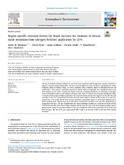Region-specific emission factors for Brazil increase the estimate of nitrous oxide emissions from nitrogen fertiliser application by 21%
Date
2020Author
Mazzetto, Andre M.
Styles, David
Gibbons, James
Arndt, Claudia
Misselbrook, Tom H.
Chadwick, Dave R.
Type
Artículo
Metadata
Show full item recordAbstract
The use of synthetic nitrogen fertilisers is one of the most important land management practices proposed to improve crop and pasture productivity. The use of such fertilisers in excess can lead to greenhouse gas (GHG) emissions, linked to climate change, as well as ammonia (NH3) emissions, linked to eutrophication and soil acidification.. This context is especially important in Brazil, which is responsible for a significant share of the food produced in the world. To assess the impact of the use of nitrogen fertilisers, we conducted a structured review of Brazilian studies on the emission of nitrous oxide (N2O; 11 studies) and ammonia volatilisation (NH3; 13 studies) from nitrogen fertiliser application. The current emission factors (EF) suggested by the IPCC for N2O and NH3 (1 and 11%, respectively) are lower than the mean values we found in our review (1.12 and 19%, respectively). Our results showed that non-urea fertilisers (ammonium nitrate or ammonium sulphate) had a lower emission factor (EF) for N2O (1.07 and 0.60%, respectively) and NH3 (3.17 and 14%, respectively) in comparison with urea. The use of nitrification and urease inhibitors resulted in a reduction of the EFs of N2O (74% lower) and NH3 (43% lower) when compared with the Urea EF. Urea is the most common fertiliser used in Brazil, and the change for non-urea fertilisers or the use of inhibitors could lead to a reduction of 23% in the total N2O inventory. The use of the new region-specific EFs results in an increase of 21% in the final N2O emission inventory.
Keywords
Publisher
Elsevier, Ámsterdam, Países Bajos
Is part of
Atmospheric Environment
URI (Permanet link to cite or share this item)
https://repositorio.catie.ac.cr/handle/11554/9471https://doi.org/10.1016/j.atmosenv.2020.117506


